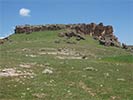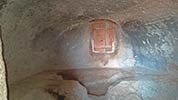Kümbet Valley is located approximately 70 km south of Eskişehir and 8 km west of Midas City, and stretches for 6 km from northwest to southeast. The valley is almost at the center of the Phrygian highlands. Kümbet village within the valley is the location of an old Phrygian settlement.
It is a typical Phrygian fortress on a rocky hill, dominating the mountain roads of the Kümbet Valley and Beldere route, 1.5 km northeast of Kümbet village at the north side of the valley. It has a stepped and ramped entrance from the north. There are silos carved into the bedrock, as well as rock carved rooms and a monumental cistern covered with a vaulted ceiling.
Click on the pictures for larger images.
About 300 m northeast of the fortress, there is a small Phrygian façade on the eastern face of a rock called Berberini. This façade was first identified by E. Brandenburg in 1901. The monument is quiet weathered and the figure in the middle of the niche, presumably the mother goddess Matar, was destroyed and a cross mark was engraved instead. There is an Old Phrygian inscription (W‑02) on the flattened rock surface over the pitched roof of the façade. The monument is dated to the mid-6th century BCE. On the west side of the same rock, there is a rock church built during the Byzantine period.
It is a rock that rises alone about 500 m north of Kümbet village. Although it is a part of the Roman necropolis, a tomb on the southeast of the rock shows features of the Phrygian period. The two rock beds inside on the right and left probably belong to the Phrygian period. A third one roughly carved behind them and the richly embroidered façade at the entrance of the tomb must have been added during reuse in the Roman period.
It is one of the best-known monuments in the vicinity with its high relief and rich patterns on the pediment. It is a rock tomb originally built in the Phrygian period. However, it was later expanded and re-used in the Roman period. The reliefs on the outer surface were added in the Roman period too. It is referred to as Solon's Tomb on account of the name "Solon" read in the inscription inside the tomb. At the entrance before the burial chamber, there is a small landing area which is a typical Phrygian feature. The recess carved on the left of this landing area is an addition during the Roman period. Considering the large size of the burial chamber, Haspels classifies this Phrygian tomb in Group II (see Descriptions). It is dated to the 6th century BCE.
It is a small fortress on a high cliff to the east of the Kümbet Village. It may have been used as a watchtower since its location also overlooks Midas City and Pişmiş Kale to the east, Kümbet Asar Kale to the north and Yapıldak and İnli Valleys to the south.
It is located almost midway between Ballık Kale and Doğanlı Kale, on the northern slope of the Yağlıdere Valley, which is one of the eastward extending narrow side valleys of the Kümbet Valley. There are hardly any remnants of the fort. Only some of the large cut stone blocks forming the moldings of the large entrance gate in the south-southeast are still visible. Due to its location, it may have been served more like an intermediate outpost.
Yapıldak is a Phrygian settlement located at the southern end of Kümbet Valley. Yapıldak Asar Kale is located on a rocky plateau approximately 500 m southwest of the village of the same name. It is in a position to see the entire Kümbet Valley. There are chamber tombs with monumental facades and relief decorations from the Roman and Byzantine periods in the western part, which descends with a slight slope towards the valley floor. The eastern part is surrounded by steep cliffs. In this section, there are several silos, a large cistern with stairs, and a two-room Phrygian rock-cut tomb with a monumental, relief-decorated entrance. The outer façade of the tomb was worked in relief in the form of a typical Phrygian building with a pitched roof. There is an animal figure on each sides of the king post in the gable. There is no consensus among the researchers, but most believe the animals are a horse and a bull. A third room was probably added to the tomb during the Byzantine period. The ceiling has a pitched roof, but there is no bed. Despite its elaborate design in contrast to the plain tombs of the early Phrygian period, Haspels classifies the Yapıldak tomb in the Group I tombs (see Descriptions).
References:
Berndt-Ersöz, S. 2006. Phrygian Rock-Cut Shrines. Structure, Function and Cult Practice, Leiden.
Haspels, C. H. E. 1971. The Highlands of Phrygia. Sites and Monuments, Princeton.
de Laborde, L. 1838. Voyage de l'Asie Mineure Par Mrs. Alexandere de Laborde, Becker, Hall et Leon de Laborde, Paris.
Tüfekçi-Sivas, T. 1999. Eskişehir-Afyonkarahisar-Kütahya İl Sınırları İçindeki Phryg Kaya Anıtları, Anadolu Üniversitesi Yayınları No:1156, Eskişehir.
Image sources:
L. de Laborde, 1838
Guillaume Berggrenn, 1889
C. H. E. Haspels, 1971
Ben Claasz Coockson, 2016
Ertuğrul Anıl, 2020, 2021
Bora Bilgin, 2020
Sibel Bilgin, 2020
Tayfun Bilgin, 2020



























